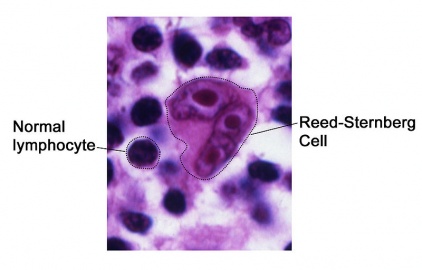Hodgkin's Lymphoma
Original Editors - Ann Bedwell from Bellarmine University's Pathophysiology of Complex Patient Problems project.
Lead Editors - Your name will be added here if you are a lead editor on this page. Read more.
Definition/Description[edit | edit source]
Hodgkin’s Lymphoma, also known as Hodgkin’s disease, is “chronic, progressive, neoplastic disorder of lymphatic tissue characterized by the painless enlargement of lymph nodes with progression to extralymphatic sites such as the spleen and liver.”1 It may also metastasize to bone marrow and other organs.2 The sites initially affected are the lymph glands in the neck or groin, usually on one side.
This type of cancer is malignant and may travel to other parts of the body. As it progresses, it may compromise the body’s ability to fight infection since it is attacking the immune system.3
Hodgkin’s lymphoma is differentiated from other cancers and Non-Hodgkin’s lymphoma (connect to page) by the type of cell involved. The Reed-Sternberg cell is “part of the tissue macrophage system and have twin nuclei and nucleoli that give them the appearance of owl eyes.”4 There are two subtypes of Hodgkin’s lymphoma, classic and nodular lymphocyte-predominant. Classic Hodgkin’s lymphoma is further divided into four categories based on what the cell looks like under a microscope. These are Lymphocyte-rich classical Hodgkin lymphoma, Nodular sclerosis Hodgkin lymphoma, Mixed cellularity Hodgkin lymphoma, Lymphocyte-depleted Hodgkin lymphoma.5
[edit | edit source]
This type of cancer is malignant and may travel to other parts of the body. As it progresses, it may compromise the body’s ability to fight infection since it is attacking the immune system.3
Hodgkin’s lymphoma is differentiated from other cancers and Non-Hodgkin’s lymphoma (connect to page) by the type of cell involved. The Reed-Sternberg cell is “part of the tissue macrophage system and have twin nuclei and nucleoli that give them the appearance of owl eyes.”4 There are two subtypes of Hodgkin’s lymphoma, classic and nodular lymphocyte-predominant. Classic Hodgkin’s lymphoma is further divided into four categories based on what the cell looks like under a microscope. These are Lymphocyte-rich classical Hodgkin lymphoma, Nodular sclerosis Hodgkin lymphoma, Mixed cellularity Hodgkin lymphoma, Lymphocyte-depleted Hodgkin lymphoma.5
Prevalence[edit | edit source]
add text here
Characteristics/Clinical Presentation[edit | edit source]
add text here
Associated Co-morbidities[edit | edit source]
add text here
Medications[edit | edit source]
add text here
Diagnostic Tests/Lab Tests/Lab Values[edit | edit source]
add text here
Etiology/Causes[edit | edit source]
add text here
Systemic Involvement[edit | edit source]
add text here
Medical Management (current best evidence)[edit | edit source]
add text here
Physical Therapy Management (current best evidence)[edit | edit source]
add text here
Alternative/Holistic Management (current best evidence)[edit | edit source]
add text here
Differential Diagnosis[edit | edit source]
add text here
Case Reports/ Case Studies[edit | edit source]
add links to case studies here (case studies should be added on new pages using the case study template)
Resources
[edit | edit source]
add appropriate resources here
Recent Related Research (from Pubmed)[edit | edit source]
see tutorial on Adding PubMed Feed
Extension:RSS -- Error: Not a valid URL: Feed goes here!!|charset=UTF-8|short|max=10
References[edit | edit source]
see adding references tutorial.







